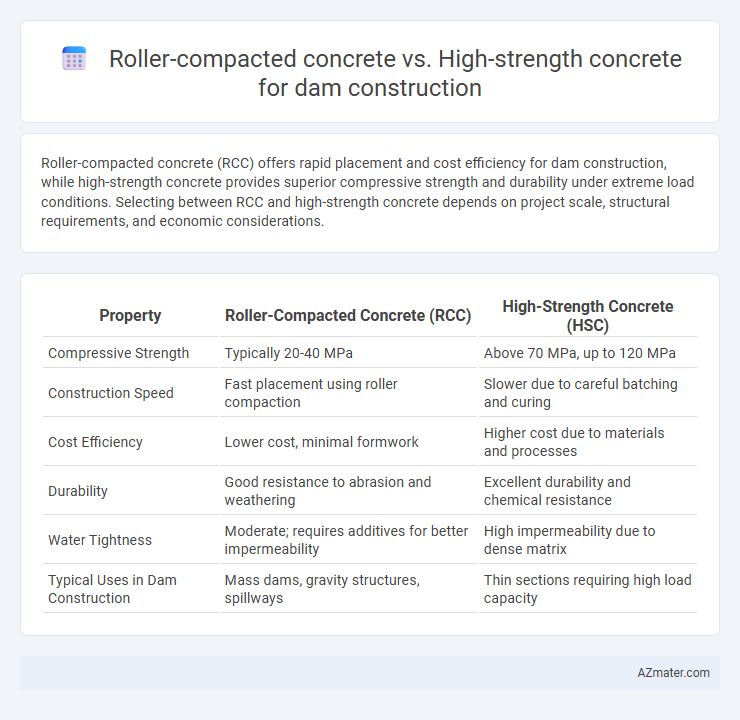Roller-compacted concrete (RCC) offers rapid placement and cost efficiency for dam construction, while high-strength concrete provides superior compressive strength and durability under extreme load conditions. Selecting between RCC and high-strength concrete depends on project scale, structural requirements, and economic considerations.
Table of Comparison
| Property | Roller-Compacted Concrete (RCC) | High-Strength Concrete (HSC) |
|---|---|---|
| Compressive Strength | Typically 20-40 MPa | Above 70 MPa, up to 120 MPa |
| Construction Speed | Fast placement using roller compaction | Slower due to careful batching and curing |
| Cost Efficiency | Lower cost, minimal formwork | Higher cost due to materials and processes |
| Durability | Good resistance to abrasion and weathering | Excellent durability and chemical resistance |
| Water Tightness | Moderate; requires additives for better impermeability | High impermeability due to dense matrix |
| Typical Uses in Dam Construction | Mass dams, gravity structures, spillways | Thin sections requiring high load capacity |
Introduction to Dam Construction Materials
Roller-compacted concrete (RCC) and high-strength concrete (HSC) are pivotal materials in dam construction, each offering unique structural benefits and cost efficiency. RCC is favored for its rapid placement, low water content, and reduced cement requirements, enabling large-volume dam structures with enhanced durability. High-strength concrete provides superior compressive strength and resistance to environmental stresses, vital for specific dam components requiring exceptional load-bearing capacity and longevity.
Overview of Roller-Compacted Concrete (RCC)
Roller-Compacted Concrete (RCC) is a type of concrete characterized by its low cement content, zero-slump consistency, and placement techniques similar to earthworks, making it ideal for large-scale dam construction due to faster placement and reduced costs. RCC offers high durability and strength, with compressive strengths typically ranging between 20 to 40 MPa, and its layered compaction method enhances structural integrity and reduces seepage risks. This material's rapid setting time and minimal formwork requirements significantly shorten construction schedules while maintaining performance standards essential for dam stability and longevity.
Overview of High-Strength Concrete (HSC)
High-Strength Concrete (HSC) in dam construction offers compressive strengths typically exceeding 60 MPa, providing enhanced durability and load-bearing capacity compared to conventional mixes. Its lower permeability and higher density reduce water seepage, crucial for the structural integrity of dams. HSC requires precise mixture design and quality control to achieve optimal performance under high-stress, long-term environmental conditions.
Key Differences Between RCC and HSC
Roller-compacted concrete (RCC) for dam construction is characterized by its low slump, high density, and rapid placement using heavy machinery, offering faster construction and reduced costs compared to high-strength concrete (HSC). RCC typically has lower compressive strength (around 20-50 MPa) than HSC, which can exceed 70 MPa, providing enhanced durability and load-bearing capacity for critical dam sections. The mix design of RCC emphasizes minimal cement content and higher aggregate volume, while HSC involves a precise mix with low water-cement ratio and admixtures for maximum strength and durability under extreme structural demands.
Structural Performance in Dam Applications
Roller-compacted concrete (RCC) offers exceptional compressive strength and durability, making it ideal for large-scale dam construction where rapid placement and cost efficiency are critical. High-strength concrete (HSC) provides superior tensile strength and reduced permeability, enhancing structural integrity and long-term performance under high hydraulic pressures. In dam applications, RCC excels in massive gravity structures due to its cost-effective bulk placement, while HSC is preferred for sections requiring enhanced load-bearing capacity and resistance to environmental stresses.
Construction Techniques and Timelines
Roller-compacted concrete (RCC) accelerates dam construction by enabling continuous placement with heavy machinery, reducing formwork and curing time compared to conventional methods. High-strength concrete requires more meticulous batching, placing, and curing processes to achieve desired strength, often extending construction timelines due to strict quality controls. RCC's rapid compaction and faster setting properties allow for shorter project durations, making it advantageous for large-scale dam projects aiming to optimize construction efficiency.
Durability and Longevity Considerations
Roller-compacted concrete (RCC) offers enhanced durability for dam construction due to its low permeability and resistance to freeze-thaw cycles, making it highly suitable for large-scale structures exposed to fluctuating water levels. High-strength concrete (HSC) provides superior compressive strength and improved resistance to chemical attack, contributing to the extended lifespan of dams subjected to high stress and aggressive environments. Both RCC and HSC contribute significantly to longevity, but RCC's faster placement and lower maintenance needs make it a cost-effective choice for durable dam construction.
Cost Comparison: RCC vs HSC
Roller-compacted concrete (RCC) offers significant cost advantages over high-strength concrete (HSC) in dam construction due to its simplified placement process and lower cement content, reducing both material and labor expenses. RCC requires less formwork and curing time, further minimizing construction duration and associated costs. High-strength concrete, while providing superior compressive strength, demands higher-quality materials and more intensive mixing and placing techniques, resulting in increased expenditure.
Environmental Impact and Sustainability
Roller-compacted concrete (RCC) significantly reduces environmental impact in dam construction by minimizing cement content and enabling faster placement with less energy consumption compared to high-strength concrete (HSC), which requires higher cement proportions and more intensive mixing processes. RCC's lower carbon footprint aligns with sustainability goals through reduced CO2 emissions and enhanced durability, promoting longer service life with minimal maintenance. High-strength concrete, while offering superior mechanical performance, often entails greater environmental costs due to energy-intensive production and increased material extraction.
Best Practices for Selecting Concrete Type in Dam Projects
Evaluating roller-compacted concrete (RCC) versus high-strength concrete (HSC) in dam construction hinges on factors such as structural requirements, project scale, and curing conditions. RCC offers rapid placement and cost efficiency for massive gravity dams, while HSC provides superior compressive strength and durability suitable for dams requiring high stress resistance. Best practices involve assessing site-specific geotechnical data, load demands, and environmental exposure to optimize concrete selection for longevity and structural integrity.

Infographic: Roller-compacted concrete vs High-strength concrete for Dam construction
 azmater.com
azmater.com